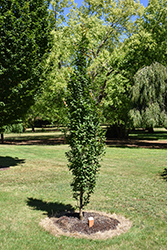Lucas Columnar Hornbeam
Carpinus betulus 'Lucas'
Height: 30 feet
Spread: 10 feet
Sunlight:
![]()
![]()
Hardiness Zone: 5a
Other Names: Common Hornbeam
Brand: J. Frank Schmidt & Son Co.
Description:
A tightly columnar tree with a strong form; best used in the landscape as an accent, for articulation, an alee tree or sheared as a tall hedge; golden fall foliage turns brown and persists into winter, adding interest; tolerates high pH and heavy soils
Ornamental Features
Lucas Columnar Hornbeam is primarily valued in the landscape for its rigidly columnar form. It has forest green deciduous foliage. The textured pointy leaves turn outstanding shades of yellow and in the fall. The smooth gray bark adds an interesting dimension to the landscape.
Landscape Attributes
Lucas Columnar Hornbeam is a dense deciduous tree with a strong central leader and a narrowly upright and columnar growth habit. Its relatively fine texture sets it apart from other landscape plants with less refined foliage.
This is a relatively low maintenance tree, and should not require much pruning, except when necessary, such as to remove dieback. It has no significant negative characteristics.
Lucas Columnar Hornbeam is recommended for the following landscape applications;
- Accent
- Shade
- Vertical Accent
- Mass Planting
- Hedges/Screening
- Windbreaks and Shelterbelts
Planting & Growing
Lucas Columnar Hornbeam will grow to be about 30 feet tall at maturity, with a spread of 10 feet. It has a low canopy with a typical clearance of 3 feet from the ground, and should not be planted underneath power lines. It grows at a slow rate, and under ideal conditions can be expected to live to a ripe old age of 120 years or more; think of this as a heritage tree for future generations!
This tree does best in full sun to partial shade. It prefers to grow in average to moist conditions, and shouldn't be allowed to dry out. This plant will benefit from an application of bonemeal and/or mycorrhizal fertilizer at the time of planting. It is not particular as to soil type or pH. It is highly tolerant of urban pollution and will even thrive in inner city environments. This is a selected variety of a species not originally from North America.

